Inner
Planets and the Moon
In the solar system there are 4 planets with rocky composition, small
sizes and orbiting the Sun at comparatively short distances from it: Mercury
(at a distance of 58 million kilometres from the Sun and with a diameter of
4878 km), Venus (108 million km; 12102 km), Earth (150 million km; 12756 km) and Mars
(228 million km; 6786 km).
Planetary
Surfaces
Two fundamental processes determine the formation of surface features of
the inner planets: impact craters and vulcanism.
Impact Craters
Structure of the Craters
The structure of a crater is determined by the energy of the impacting
projectile (size, velocity and composition), by the gravity of the hit planet,
by the tilt angle of the shock and by the structure of the soil on which the
impact occurs.
During an impact, the fragmentation and ejection of a vast quantity of
material create an initial cavity.
The ejected material is scattered for distances that are larger or
smaller, according to the lower (larger distances) or higher (smaller
distances) gravitational intensity of the hit body. The
ejected material may lead to the formation of secondary craters, more distant
from the centre.
At the centre of the crater, the ricochet provokes the appearance of a
central hill, in the case of strong impacts, or the appearance of an internal
crater, when the impacts are even stronger.
The energy of the impact may still provoke the melting of amounts of
rock that are enough to cover big surface areas, like it happened during the formation
of the lunar Maria.
Craters on Mars
On Mars, the craters are unevenly distributed along the planet's
surface, being much more prevailing in the Southern Hemisphere than in most
parts of the Northern Hemisphere. It's not known the reason for this asymmetry,
but it is thought that it might have been caused by a gigantic impact in remote
times of the Mars history.
The craters located at high latitudes clearly have more soft relieves
than the craters located at the equatorial zones, those ones being also
surrounded by flows of materials. It is thought that the ice is the cause for
the lubrication of the materials at the zones that are closer to the poles
(which provoked this softening and fluidity of the material) because,
contrarily to what happens at the low latitudes (hotter), the ice doesn't tend
to sublimate there (to directly go from solid to gaseous). So, it is kept
stable under the surface. More recently they were discovered some
formations that suggest the occurrence of liquid water flows in comparatively
recent times (few hundred million years), which could be explained by the
liquefaction of subsurface ice deposits, provoked by the geothermal activity.
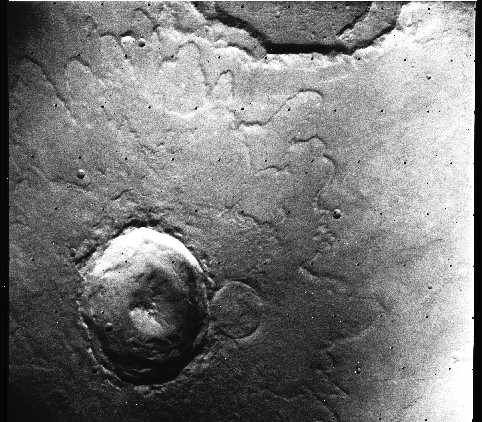
Crater Yuty, at the high
latitudes of Mars: the flow of the surrounding material unveils the presence of
ice under the surface (Viking 1 Orbiter)
Craters on Venus
On the other hand, Venus is covered by a comparatively low density of craters,
due to its surface youth. Actually, Venus seems to have crossed a period of a
very intense geological activity some 300 to 500 million years ago. This
activity may have been triggered by an unknown catastrophic event. From then
on, Venus has apparently been a geologically calm planet.
The craters with diameters bigger than 20 km seem to have been heavily
changed by lava emissions, probably arousing from the impacts' energy. On the
other hand, the smaller meteorites were fragmented by the thick Venusian
atmosphere, shaping zones of multiple impacts. Even smaller objects, totally
destroyed in the atmosphere, didn't directly touch the soil but stirred up
shock waves that provoked the smoothing of the terrain located below the
meteorites' penetration zone.
A characteristic of the Venus' craters is the asymmetry displayed by the
deposits of ejected material. The thick atmosphere forces the material of a
meteorite that hits Venus obliquely to mainly be ejected forwards, since the
thick air prevents it from flying backwards. The winds of the upper atmosphere
(50 to 75 km high) are also determining to the way that the ejected material is
deposited.
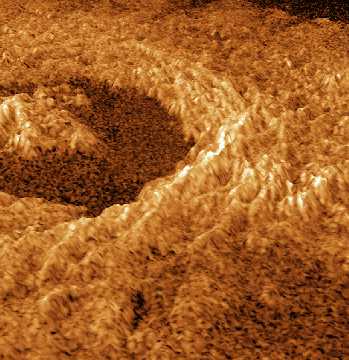
Golubkin crater in Venus
(NASA - JPL)
Craters on Earth
At the terrestrial surface, the impact craters are not common, because
they were erased by the geological activity that followed the first 600 million years of the Earth's history, during which the
planets, in their accreting processes, were heavily targeted by meteorites.
Vulcanism
The vulcanism is basically a consequence of the radioactive decay of the material existing
inside the planets, which heats the surrounding rocks until they melt. There
are three different processes through which the internal heat may be released
to the exterior: conduction, advection and plate tectonics.
Conduction and Advection
In the Moon, Mercury, Venus and Mars (which are covered by thick
crusts), the lithospheric conduction was the main process through which the
heat escaped from their interiors. It's characterized by a vertical
"tectonism", which means that the hot volcanic deposits are
accumulated at the upper regions of the crust, while the upper lithospheric
material sinks in the planet's interior. On Venus, this sinking may be the
responsible cause for the existence of vast regions of wrinkled and disfigured
terrain, known as Tesseræ. On the other hand, on Mars, the accumulation of
deposits at the upper zone of the crust might have been the responsible
mechanism for the arising of the volcanic region of Tharsis, which is located
above the average altitude of the planet.
The advection is not very different from the lithospheric conduction and
it is a process that is present in Io and, in a smaller scale, also in
Mars. It's characterized by the direct transference of heat to the exterior,
through volcanic eruptions and lava flows. It's a mechanism that is based in
the existence of hot spots.
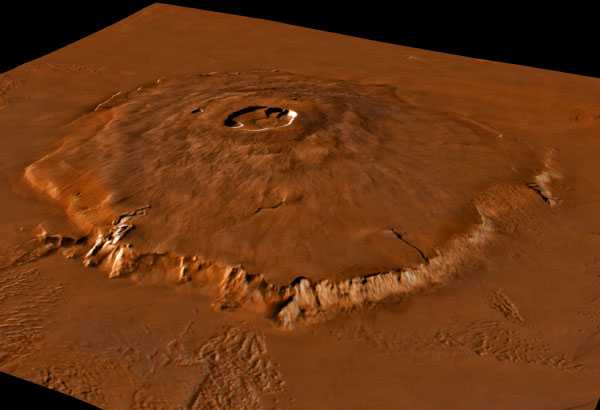
The Olympus Mons volcano,
on Mars (Calvin J. Hamilton)

Eistla Regio, on Venus - lava plains
(NASA - JPL)
Horizontal Tectonism
Finally, the process that determines most of the volcanic activity on Earth is the horizontal tectonism, which
is characterized by the segmentation of the lithosphere in plates that move
with respect to one another. This process is oiled by the existence of liquid
water, because this one allows the constant recycling of the CO2.
In the zones where the plates diverge, "rifts" arise due to
the upwelling of matter proceeding from the mantle and to the subsequent
symmetric spreading, contraction and sinking, until the material stabilizes at
lower altitudes. Two examples of this kind of topography are the mid-Atlantic
ridge and the "rift" valley in eastern Africa.
When an oceanic plate collides with a continental plate, the first one
(more dense) tends to sink under the latter (lighter). For that reason, we may
say that the shape of the continents resists against the tectonic movements,
contrarily to the shape of the oceans. This process is known as subduction,
which is namely responsible for the Peru-Chile oceanic trench, along the
western coast of South America, and for its counterpart - the belt of volcanoes
that gave birth to the Andes, originated from the re-ascension of the light
materials sunk during the process. These zones are affected by deep
earthquakes, due to the sinking of the material down to depths of 600 km or
more.
The subduction in a determined region reaches its end when all the
oceanic crust was consumed by it. An example is the collision between the Asia
and India, which provoked the formation of the Himalayan. The collision between
these two continents drove to the compression and uplifting of this mountain
chain, which is still affected by earthquakes. In a few million years the
movement between both continents will stop and a new subduction zone will
probably arise to the South of India in order to replace the previous one, when
this will have become completely inactive.
The last tectonic movements that are worth to mention are the so-called
transform faults. In these zones there is neither convergence nor divergence:
the plates slide past each other. This is the case of the San Andreas Fault, in
California.

Tectonic map of Earth:
the yellow lines represent the borders between the plates (NGDC)
Shapes and Dimensions of the Volcanoes
It's still worth to mention that what distinguishes the big Martian
volcanoes, like the Olympus Mons, from terrestrial volcanoes like the Hawaiian
(not triggered by any tectonic process but rather by a hot spot laying below
them, like it happens in Mars):
1.
First, the plate where Hawaii is located moves, causing the arouse of an
alignment of volcanoes instead of one single huge volcano, like Olympus;
- Second, the magma source is deeper in
Mars, subjecting the material to stronger pressures and, therefore,
making it arise to higher altitudes during the eruptions.
Along with the winds and subsurface ice, the vulcanism may have been
responsible for the existence of large plains on Mars.
On Venus, the plateaus as well as the lobate (regions where small
volcanic flows merge), reticulate and gridded terrain (deformed by the lava
cooling) seem to have a volcanic origin.
Given the enormous fluidity of the Venusian lava (which is thought to be
due to the high temperature of the atmosphere), very long lava beds were carved
on this planet (one of them, the Hildr, is longer than the Nile). These beds
are very similar to those that are carved by the water rivers on Earth.
The vaulted bulges are also typical volcanic formations on Venus, which
are believed to have been resulted from cycles characterized by the ejection of
thick and viscous lava, subsequent cooling and further ejection of new
material, located below the one that was previously ejected. This is a fracture
triggering process.
The Vulcanism Today
The vulcanism is still active on Earth and, possibly, on Venus, but on the
Moon and on Mercury it was extinguished after some hundred million years had
elapsed since the beginning of their existence. On Mars, in spite of presently
being an inactive planet, they were discovered lava flows that appear to be
only 10 to 100 million years old. The mass of the planet and, consequently,
the level of internal radioactive heat that it still keeps,
determine the activity extent that these planets preserve.
Other Factors
Besides those surface shaping processes, other ones shall be emphasized,
like the compression of a planet that is provoked by its cooling (triggering
the formation of ridges, as in Mercury), the solidification of polar caps
(Earth and Mars), the winds (which namely favour the erosion and the formation
of dunes on Venus, Earth and Mars), the precipitation (rain and snow) and biological activity (on Earth).

Ridges shown at the
Caloris basin, on Mercury (Calvin J. Hamilton)
Mars
On Mars, can be emphasized the gorges (namely, the Valles Marineris) and
the ancient riverbeds, revealed by their shapes, by sediments deposits and by
the branching of river-like tributaries.
The biggest gorges seem to have been essentially formed by terrain
fissuring and sinking processes, although scientists believe that the water
also had an important role on their framing, namely through the catastrophic
release of big lakes that carved, for instance, the canyon linking the Candor
Chasma and the Ophir Chasma.
The existence, in an ancient epoch, of
copious amounts of liquid water is an indicator that the climate,
by that time, shall have been much hotter than it is today and it would
probably be cyclically interrupted by glacial periods.
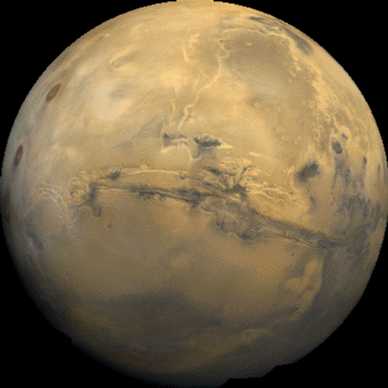
Valles Marineris, the
Martian amplified version of the Grand Canyon (USGS)
The polar caps of Mars are composed by permanent water ice (like on
Earth) and by seasonal CO2 ice (in Winter) that, during the Summer,
completely sublimates at the northern cap and partially sublimates at the
southern cap. The deposit of dust layers on the caps is linked to the global
climate, namely to the raising of winds that drag them to those regions. Along
with the water contained in the polar caps, it's thought that a much higher
quantity is captive under the surface.
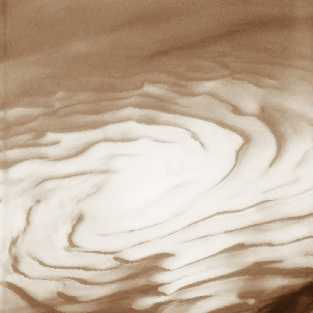
Northern polar cap, on
Mars (Calvin J. Hamilton)
The
Interiors
It's estimated that the interior of the inner planets and the Moon are
mainly composed by a core of heavy materials (like iron and nickel), a mantle
composed by lighter materials (like silicates) and a thinner crust. It's also
thought that the terrestrial core is divided between a solid inner core and a
hot and liquid outer core, where the electric currents that determine the
creation of the magnetic field are generated.

The interior of Mars
(Calvin J. Hamilton)
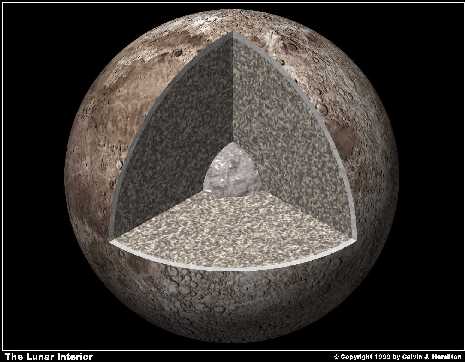
The interior of the Moon
(Calvin J. Hamilton)
The Magnetic Fields
The metallic alloy contained in the core is a good electric conductor
and the interaction between the planet rotation and the convection produces a
"dynamo effect", which generates the dipolar magnetic field of the
Earth. The magnetic fields of the Moon and the other inner planets are much
weaker than the Earth's. The slow rotation of a planet can determine the
absence of any noticeable magnetic field, as it happens on Venus.
The Radioactive Heating
The planetary nuclei are heated by the decay of the radioactive atomic nuclei that were produced in supernovae. The melting of the materials
produced through this process favoured the differentiation between a core
composed by heavy materials and a mantle composed by light materials.
Planetary
Atmospheres
The atmospheres of the inner planets display clearly distinct
characteristics. As Mercury displays an almost complete absence of an
atmosphere, Venus is enshrouded in an atmosphere that is 90 times heavier than
the terrestrial atmosphere and Mars holds one that is 150 times lighter than
ours. The composition of the terrestrial atmosphere, composed mainly by
nitrogen (almost 80%) and oxygen (about 20%) is largely due to biological factors.
On the other hand, Venus and Mars have atmospheres essentially composed by CO2
(carbon dioxide).
Water
On Earth, the water exists mainly
under the liquid form (in the oceans), but also under the solid form (polar caps)
and the gaseous form (water vapour). On Mars, the water exists mainly under the
solid form (in the polar caps and as ice crystals right below the surface
regolith – the rocky and dusty layer that lies at its top), also existing some
under the gaseous form (as a result of the sublimation), in equatorial regions.
This water shall return back later to the soil and freeze again. On Venus,
given the high temperatures, its little amount of atmospheric water exists
exclusively under the form of vapour. In the colder regions of the upper
atmosphere (between 50 and 80 km above the surface), the vapour is incorporated
in sulphur acid droplets.

Measure of hydrogen in
Martian soil: “Blue” zones revealing
the presence of water ice (2001 Mars Odyssey Mission)
Ozone
On Earth, the ultraviolet
radiation breaks the molecular oxygen (O2) in 2 atoms of oxygen (O),
subsequently bound to form the ozone (O3). On Venus and Mars, the
ultraviolet radiation splits the CO2 into CO (carbon monoxide) and O
(atomic oxygen), which later is bound to form the ozone.
Sulphur
The hot atmosphere of Venus prevents the removal of the sulphur left by
the volcanic activity, contrarily to what happens on Earth (where the sulphur returns to the
soil, incorporated in water droplets or in other materials). Therefore, the
sulphur dioxide (SO2) abounds at the Venusian lower atmosphere,
providing a chemical source for the dense layer of sulphur acid particles (H2SO4).
Greenhouse Effect
The greenhouse effect affects the inner planets temperatures, through
the atmospheric absorption of the heat emitted by the surface and its
re-radiation back to the ground. This effect makes the temperature increase 5
ºK (1 ºK = 1 ºC) on Mars, 35 ºK on Earth and 500 ºK on Venus.
The main actors of the greenhouse effect are the carbon dioxide (on
Venus, Earth and Mars), the water vapour (on Venus and Earth), sulphur dioxide
and sulphur acid clouds (Venus), the water clouds (Earth) and the suspended
dust particles (Mars). However, the dust and sulphur acid particles tend to
heat the atmosphere around them but to cool the lower atmospheric layers, due
to the absorption of the solar light.
Structure of the Atmosphere
Troposphere
On Earth, the atmosphere is
structured in several layers. At the inferior layer, known as troposphere, the
temperature tends to fall in the rising direction, given the high concentration
of greenhouse particles (mainly water vapour and carbon dioxide) at the lower
zones. These particles are opaque to the infrared (thermal) radiation coming
from the ground. As we go up in the troposphere, the amount of heat received
from the surface decreases because those mentioned gases block it.
The cooling provoked by this phenomenon is partially compensated by
several convective mechanisms of warm transportation, like the water
evaporation and condensation at higher regions.
Stratosphere
At the layer immediately above, the stratosphere, the temperature tends
to rise with the altitude due to the absorption of the ultraviolet radiation by
the ozone.
Mars and Venus, given the little amount of ozone that can there be
found, are not provided with any stratosphere.
Mesosphere
Above the stratosphere there is a layer called the mesosphere. In the
mesosphere, the temperature decreases again with the altitude, given the lack
of ozone and the blockade of the heat by the carbon dioxide particles
(greenhouse gas), just as it happens in the troposphere.
Thermosphere
At the upper layer of the atmosphere, known as thermosphere, the
temperature increases again with the altitude (up to more than 1000 ºC or about
1270 ºK), due to the heating caused by the ultraviolet radiation proceeding
from the Sun. However, the low density of the thermosphere makes those high
temperatures to be nearly harmless for the vehicles that transit this region.
In the thermosphere, the ultraviolet radiation tears the electrons away
from the few atoms and molecules existing there, creating an environment of
electrically charged particles (ions with positive charge and electrons with
negative charge).
The thermospheric heating is weaker on Mars and Venus than on Earth, because the higher quantities of
carbon dioxide that are present in both planets act as better irradiators of
the absorbed ultraviolet energy.
Atmospheric Pressure
Just as in the troposphere, the atmospheric pressure decreases with the
altitude, in a scale of 3 for each 10 km, in all the inner planets.
The Last Frontier
The frontier between the atmosphere and the interplanetary space is
established by the boundary where it interacts with the solar wind – the fast and ionized gas
proceeding from the Sun.
Winds
There are several mechanisms that may determine the wind pattern in a
planet.
The Hadley Circulation
Among the mechanisms that may influence the winds pattern in a planet, the
most better known is the so-called Hadley circulation, which is responsible for
the rising of the hot air in the equatorial regions, subsequent cooling and
transportation to higher latitudes. There, the hot air returns back to the
ground and, travelling at lower altitudes, it is transported back to the
equatorial latitudes.
On Mars and Venus, one single cell spans the entire distance from the
equator to each of the poles, but on Earth there are 3 cells in each
hemisphere. On Venus, there are probably several cells located at different
altitudes.
The Coriolis Force
The rotating planets' winds are still affected by the Coriolis force,
which deflects the air perpendicularly to the its direction of motion. This
force adds an east-west component to the north-south natural movement of the
Hadley circulation.
Baroclinic Eddies
Other phenomena that are typical in the planetary meteorology are the
baroclinic eddies. They are characterized by cyclones (low pressures) and
anticyclones (high pressures) systems and arise when the differences between
the temperatures of two adjoining latitudes become very high.
They constitute an efficient mechanism for transporting the heat in the
direction of the poles and in an ascending direction. They also help to keep an
east-west fast motion, known as the jet stream.
Stationary Eddies
On the other hand, the stationary eddies are known for transporting the
heat from the low altitudes to the higher ones. They can be triggered by the
topography or by the difference of temperatures between the oceans and the
continents.
Condensation Flows
Other meteorological processes are the condensation flows, which exist
only on Mars. They are caused by the low pressures created on the hemisphere
where the CO2 is condensed. A global stream forms to transport the
heat into the low-pressure region existing over the pole.
Thermal Tides
One last process that is worth to mention are the thermal tides,
provoked by the temperature differences between the night and day hemispheres.
This phenomenon is much more intense on Mars than on Earth, because the diurnal
temperature differences are much higher on the red planet. These high thermal
differences are, in turn, due to the rarefaction of its atmosphere.
Dust Storms
Mars is also known for its huge dust storms. The dust is dragged by fast
winds and sometimes they may cover large areas of the planet with one single
cloud. These winds are generated during the Spring and the beginning of the
Summer on the Southern Hemisphere, when the planet is closer to the Sun.
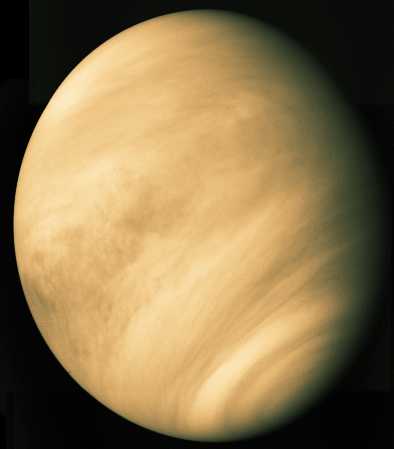
The dense and corrosive
atmosphere of Venus (Calvin J. Hamilton)
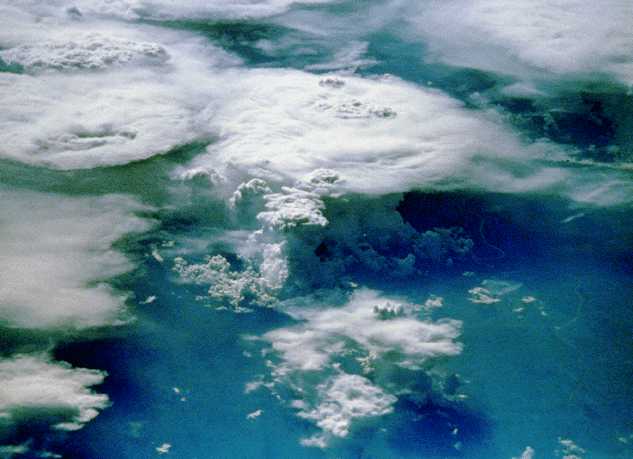
The placid terrestrial
atmosphere: clouds over Brazil (LPI - NASA)
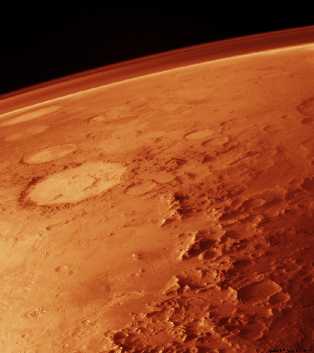
The tenuous atmosphere of
Mars (Calvin J. Hamilton)
Composition and Evolution of the
Atmospheres
Only one tiny portion of the material that formed the solar system was
preserved in its inner regions, as it is proven by the low quantities of
hydrogen and helium existing there (the main components of the primordial nebula).
Volatile Materials
When compared with heavy elements such as magnesium, silicon or iron, even
elements or molecules with intermediate atomic weight like the carbon (C), the
nitrogen (N) or the water (H2O) are now 10 000 times rarer than they
were in the primordial nebula.
Nevertheless, the volatile materials like the carbon, the nitrogen or the
water had an extremely important role in the formation of the atmospheres of
Venus, Earth and Mars, as well as in
the formation of the polar caps (Earth and Mars) and the oceans (Earth).
Given the greater distance of Mars from the Sun, it should have been in
its region that the volatile materials were more plentiful. However, since
Venus and the Earth accumulated bigger masses, at the end of the process these
ones would have a gravity more able to redirect planetesimals into more internal
orbits.
There is also the chance that the volatile materials would have been
gathered from planetesimals that formed farther away, in the exterior solar
system. If they came from the asteroid belt, hydrated minerals would
have brought the water. If the volatile-rich planetesimals proceeded from even
more distant places, from the region of the giant planets, the water would have
rather been brought under the form of ice. In both cases, the carbon and the
nitrogen would have been brought under the form of organic compounds.
Venus vs. Earth, Present vs. Past
On Venus, given its high surface temperature, most of the carbon (C) and
the nitrogen (N) stay in the atmosphere incorporated in molecules like CO2
and N2. On the other hand, almost all the carbon existing on Earth is contained in the rocks. However,
just as on Venus, most of the terrestrial nitrogen is contained in the
atmosphere. It's thought that in the beginning Venus and Earth possessed comparable quantities of
water (which was lost in Venus), carbon and nitrogen (which were kept in both
planets).
Proto-Atmospheres
During the primordial times of the solar system, the planetesimals would have collided with
the proto-planets at a low velocity,
because the still low gravities were unable to accelerate these objects. For
that reason, the volatile materials were not vapourized during the impacts.
Later, when the collisions became energetic enough, the volatile
materials started to be increasingly released. On Venus and on Earth, most of these materials would have
been released, while on Mars only partially they would have been so.
In cold enough atmospheres, the water vapour would have been condensed
in oceans or solidified in ice deposits.
Escapes to Space
Two processes determined the escape of atmospheric material into the
space:
1.
In first place, there were impacts of objects large enough, thus heating
so much the surrounding atmosphere that this would become able to escape.
- In second place, the ultraviolet radiation
splits the water into atomic hydrogen (H), molecular hydrogen (H2),
atomic oxygen (O) and hydroxyl (OH). Later, it provokes the heating of
the atomic (H) and molecular hydrogen (H2), exciting it and
paving the way for its escape. It was through this process that Venus
lost its water. On Earth, the process was probably
braked by the emission of oxygen by the biological
organisms existing on its surface. The oxygen was bound again with the
hydrogen, preventing it from escaping into the space.
Hellish Atmospheres
The planets, during their childhood, received less solar energy (because
the Sun was colder, by that time) but were heated by the impacts of the
meteorites. This would drive to the evaporation of the water that, for being a
greenhouse gas (it retains the heat), drove to an even more intense water
evaporation. The temperatures would have gone up, on Venus and on Earth, until
they reached about 1500 ºK. The surfaces would be partially molten under a very
dense and vapour dominated atmosphere.
The Agonizing Saga of Venus
The atmospheric pressure would have prevented the complete evaporation
of the water on Venus, allowing the existence of oceans under temperatures
above 373 ºK (100 ºC). On Earth, the decrease in the number of
impacts favoured the fall of the temperature down to the actual 300 ºK.
On Venus, the water was gradually lost through the already mentioned
process. With the end of the oceans (which constantly evaporated, in order to
replenish the atmospheric vapour that continuously was escaping into space),
the CO2 was unable to return back to the rocks under the form of
carbonates. It remained in the atmosphere, thus becoming the cause of the
presently observed greenhouse effect and the high atmospheric pressure (about
90 times the Earth's atmospheric pressure).
The Nostalgic Saga of Mars
On Earth, the carbon cycle is
characterized by its incorporation in the rocks (brought about by the oceanic
action) and further return to the atmosphere through tectonic processes and
volcanic eruptions.
In ancient times, Mars probably was dominated by a greenhouse effect that
provoked the melting and evaporation of the water. The oceans favoured a carbon
cycle similar to the terrestrial one. Afterwards, when vulcanism decreased
(probably during the first billion years), the CO2 stopped returning
back to the atmosphere and, as a result, the air cooled and the water froze.
Most of the CO2 was forever confined in the rocks.

Image of the Gusev crater,
sent by the Mars Opportunity probe in 2004. It’s thought that this crater was
bathed by a sea during a period subsequent to its formation. The water would have been drained into this crater through a
large channel, called Ma’adim Vallis (NASA)
The Gloomy Saga of Mercury
It is thought that even Mercury possessed, in very ancient times, an
atmosphere of CO2 and H2O, proceeding from planetesimals
brought from regions that were farther away from the Sun. It would be, like the
Earth and Venus, dominated by
a greenhouse effect.
The powerful solar wind (Mercury is the closest planet from the Sun and
it's more vulnerable to its effects), the ultraviolet radiation and its low
gravity should have favoured the complete loss of its atmosphere into the
space.
Nowadays, the only elements present in the atmosphere of Mercury –
helium and sodium – have an external origin, being brought by the same solar
wind that once destroyed its primordial atmosphere.
Moon
The Mega-Impact
It's thought that the Moon was created when, about 4.5 billion years
ago, a body with dimensions comparable to Mars collided with the primitive Earth. The impact expelled a
jet of molten or vapourized rock, most of which ended up scattering in the
interplanetary space or falling back to Earth. However, a remainder kept orbiting
our planet and its fragments finally accumulated to form the Moon.
The Lunar Childhood
A global ocean of liquid rock, with a thickness of some hundred
kilometres, covered then our satellite. A differentiation process began: the lighter
crystals went up to the upper layers, where they accumulated in floating solid
fragments, while the heavier ones, rich in magnesium and iron, sank to form a
mantle.
The crust solidified as the satellite cooled, having been left only an
ocean of residual magma between the crust and the mantle. This ocean should
have been composed by elements that don't easily bind into mineral structures
during a crystallization process, like the one that occurred.
However, dense materials kept overlaying lighter and hotter elements.
The unavoidable happened and a convective process was re-ignited, having the
magnesium-rich materials ascended from the mantle up to the crust, while the
iron-rich materials sank. This process lasted for about 500 million years.
Gigantic Impacts
Gigantic impacts had a deep influence on shaping the lunar geology. Such
impacts drilled the crust, fragmented materials and produced molten rock (lava)
seas, the so-called "Maria", which covered the regions around the
places of the impacts.
2 billion years after its formation, the Moon cooled enough for the
volcanic activity to completely cease, having been converted into an entirely
solid and lifeless body, as we know it today.
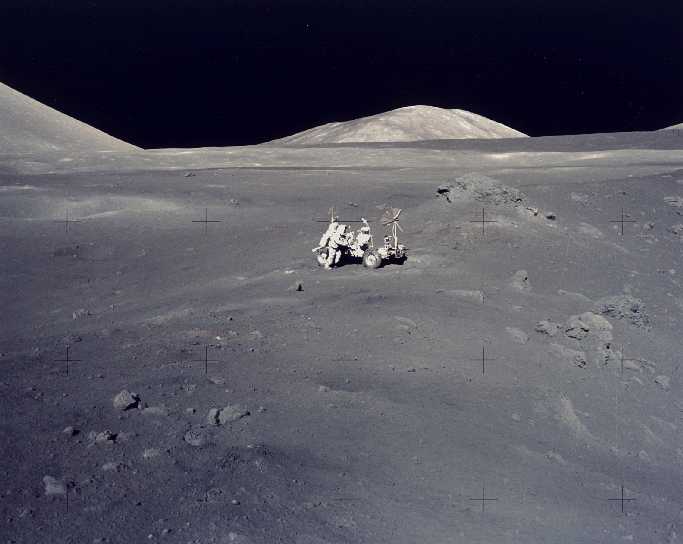
Lunar landscape (NASA)
_